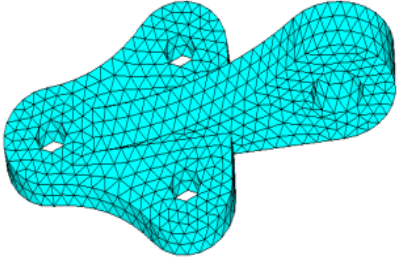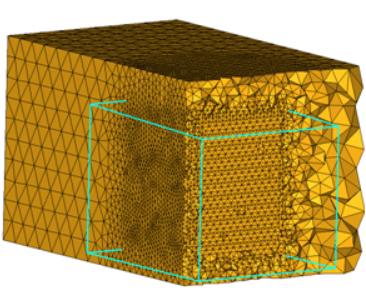Tetra Meshing
Use the Tetra tool to fill an enclosed volume with first order or second order tetrahedral elements.
A region is considered enclosed if it is entirely bounded by a shell mesh (tria and/or quad elements). Hexahedral, wedge, and pyramid element configurations can also be generated during tetra meshing. These elements are typically generated when you need boundary layer type meshes on certain areas of the volume surface.
Create Tetra Mesh
Use the Create tool to create tetra mesh from closed volumes of shell elements, or from solid or closed surface geometry.

Figure 2.
Remesh Tetra Mesh
Use the Remesh tool to regenerate the mesh for a single volume of tetrahedral elements.

Figure 4.
Tetra Mesh Options
Create
- Element size definition
- The mesh size definition used to create the tetra mesh.
- Average size
- The average element size used to create the tetra mesh.
- Maximum size
- The maximum element size used to create the tetra mesh.
- Growth rate
- The factor to control the rate of transition in case of element size change.
- Layered tetra
- Enable layered element generation in close proximity areas.
- Number of layers
- The number of layers to use.
- Fix invalid surface mesh
- Fix invalid input surface mesh before tetra mesh creation.
- Quality control criteria
- The quality control criteria to be used while creating the tetra mesh.
- Tetra collapse >
- Optimize the tetra elements to have tetra collapse greater than this value.
- Cell squish <
- Optimize the tetra elements to have cell squish less than this value.
- Volume skew <
- Optimize the tetra elements to have volume skew less than this value.
- Fill voids
- Fill the innermost cavity while creating the tetra mesh.
- Fix mid-nodes for a second order mesh
- Fixes the mid-node positions for a second order tetra mesh.
- Meshing method
- The meshing method to be used when creating the tetra mesh.
- Mesh destination
- The component in which the tetra mesh is to be organized.
- Restrict minimum size
- Restricts the minimum size of the tetra mesh
- Minimum size
- The minimum size of the tetra mesh.
Remesh
- Element size definition
- The mesh size definition used to create the tetra mesh.
- Average size
- The average element size used to create the tetra mesh.
- Maximum size
- The maximum element size used to create the tetra mesh.
- Quality control criteria
- The quality control criteria to be used while creating the tetra mesh.
- Tetra collapse >
- Optimize the tetra elements to have tetra collapse greater than this value.
- Cell squish <
- Optimize the tetra elements to have cell squish less than this value.
- Volume skew <
- Optimize the tetra elements to have volume skew less than this value.
- Fix mid-nodes for a second order mesh
- Fixes the mid-node positions for a second order tetra mesh.
- Surface mesh treatment
- The surface mesh treatment method to be used while remeshing.
- Mesh destination
- The component in which the tetra mesh is to be organized.
- Restrict minimum size
- Restricts the minimum size of the tetra mesh
- Minimum size
- The minimum size of the tetra mesh.

 to define tetra mesh
options.
to define tetra mesh
options.